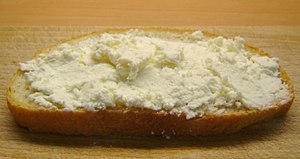| Revision as of 11:43, 9 February 2006 edit80.80.111.240 (talk)No edit summary← Previous edit | Revision as of 17:26, 9 February 2006 edit undoMkahanec (talk | contribs)14 editsmNo edit summaryNext edit → | ||
| Line 1: | Line 1: | ||
| ] | ] | ||
| '''Bryndza''' is a ]'s ] ] made in Eastern ], ], ],] ] and ]. |
'''Bryndza''' is a ]'s ] ] made in Eastern ], ], ],], ] and ]. Bryndza originated in what is now ] in ] and thus its name it is derived from the romanian name for cheese - ''brânză''. It probably came to Slovakia in the course of the settling of northern Slovakia by the ] from the ] to the ]. The first written mention of bryndza in Slovakia appeared in the late ]. From the ] onwards it was made in Slovakia and began to spread to neighbouring regions. | ||
| The process for making bryndza is similar to that for making ]. The sheep's milk is strained through linen into small wooden casks named ''burduf'' or ''putera''. The putera are often made from ] or ] wood. The temperature of the milk is raised to 30-35°C before further processing takes place. After numerous stages of processing, a cheese paste is produced. This is shaped and then left to lie for 5 to 6 days. During that time, in order to prevent ] and to ensure that the cheese matures equally, the cheese is regularly turned and wiped. After six days, a thin crust develops. This is removed and the cheese is melted and salt is added to it. This fine melted salt cheese is the finished bryndza. In some regions, ] or ] are added to the plain cheese. | The process for making bryndza is similar to that for making ]. The sheep's milk is strained through linen into small wooden casks named ''burduf'' or ''putera''. The putera are often made from ] or ] wood. The temperature of the milk is raised to 30-35°C before further processing takes place. After numerous stages of processing, a cheese paste is produced. This is shaped and then left to lie for 5 to 6 days. During that time, in order to prevent ] and to ensure that the cheese matures equally, the cheese is regularly turned and wiped. After six days, a thin crust develops. This is removed and the cheese is melted and salt is added to it. This fine melted salt cheese is the finished bryndza. In some regions, ] or ] are added to the plain cheese. | ||
Revision as of 17:26, 9 February 2006

Bryndza is a sheep's milk cheese made in Eastern Austria, Poland, Romania,Russia, Slovakia and Ukraine. Bryndza originated in what is now Transylvania in Romania and thus its name it is derived from the romanian name for cheese - brânză. It probably came to Slovakia in the course of the settling of northern Slovakia by the Vlachs from the 14th century to the 17th century. The first written mention of bryndza in Slovakia appeared in the late 15th century. From the 18th century onwards it was made in Slovakia and began to spread to neighbouring regions.
The process for making bryndza is similar to that for making quark. The sheep's milk is strained through linen into small wooden casks named burduf or putera. The putera are often made from spruce or fir wood. The temperature of the milk is raised to 30-35°C before further processing takes place. After numerous stages of processing, a cheese paste is produced. This is shaped and then left to lie for 5 to 6 days. During that time, in order to prevent mould and to ensure that the cheese matures equally, the cheese is regularly turned and wiped. After six days, a thin crust develops. This is removed and the cheese is melted and salt is added to it. This fine melted salt cheese is the finished bryndza. In some regions, onion or chives are added to the plain cheese.
After the process, the cheese contains roughly 45% of fat, 50% of water and 2-3% of salt. Like similar soft cheeses, bryndza does not keep well. Lovers of the cheese especially enjoy it when it has matured. Bryndza is only produced and sold during a few months of the year.
Bryndza is an essential ingredient for Liptauer and for bryndzové halušky ("bryndza balls"), a Slovak national dish. A similar sheep's milk cheese is used in Transylvania as a gratin for noodles (Pranz geschniddan Diech) or polenta (Paleckes mat Pranz).
References
- This article incorporates text translated from the corresponding article from the German Misplaced Pages, retrieved on May 3, 2005.